
Do not set your goals without going through these goal setting statistics and facts.
Did you know that setting specific and challenging goals leads to better performance than easy goals?
Weird, right?
We have always believed that the easier a goal is, the better our performance.
However, our research proves otherwise. There are many other goal setting statistics that will blow your mind.
So, do not set goals without going through these goal setting statistics. And you should know each one of them.
The year is still young, with plenty of opportunities to set goals. So, keep reading to know the right goals to set.
Key Highlights: Goal Setting Statistics
- 48% of goal-setters say that they always write their goals down.
- 90% of the time, setting specific and challenging goals leads to higher performance than easy goals.
- 33% of Americans will most likely set goals, 38% are somewhat likely, 21% are not very likely, and 9% are not likely at all.
- 32% of goal-setters are described as diligent planners.
- 80% of adults in the US set personal health or fitness goals
- According to 50% of surveyed workers, clear goals boost their motivation and sense of purpose.
General Goal Setting Statistics
1. Goal setting comes in 4 stages: preparation, goal setting, planning, and follow-up. (source)
2. 51% of companies aim at creating aligned goals for themselves. Of these 51%, only 6% bother revisiting their goals. (source)
3. 44% of Americans will likely make a New Year’s resolution yearly. (source)
A “New Year’s resolution” is a goal set at the beginning of the year that is intended to be accomplished over the course of the year.
4. The global performance and goal management software market was valued at $2666.7 million in 2022. It is expected to grow at a CAGR of 17.1% from 2023 to 2031. As a result, it is expected to reach $11012.2 million by 2031. (source)
5. 82% of workers claim that transparency is essential when it comes to achieving set company goals. This means that the executives should clearly explain to them what the goals are and where the company is at achieving those goals. Unfortunately, only 19% say their company is very transparent. (source)
6. 33% of workers feel collaboration would help achieve goals, and 31% of workers believe that communication channels would improve things. (source)
7. In Sweden, only 12%-18% of people plan New Year’s resolutions for themselves. (source)
8. 90% of the time, setting specific and challenging goals leads to higher performance than easy goals. (source)
9. According to research, ambitious goals reduce energy consumption by 20%, and more manageable goals minimize energy consumption by 5%. This means that more manageable goals consume more energy than ambitious goals. (source)
Statistics on Goal Setting as Individuals
10. 7 out of 10 adults in the U.S. set goals for themselves at the beginning of the year. Of these people, 38% claim they are somewhat likely to keep to their goals. (source)
11. 30% of adult Americans do not have set goals for the year. (source)
12. 79% of adults aged 18 to 34 will likely set goals. 72% of adults aged 35 to 54 are likely to set goals, and 62% of those aged 55 and above are likely to set goals. This goal-setting statistic shows that age differences influence individuals when it comes to goal-setting. (source)
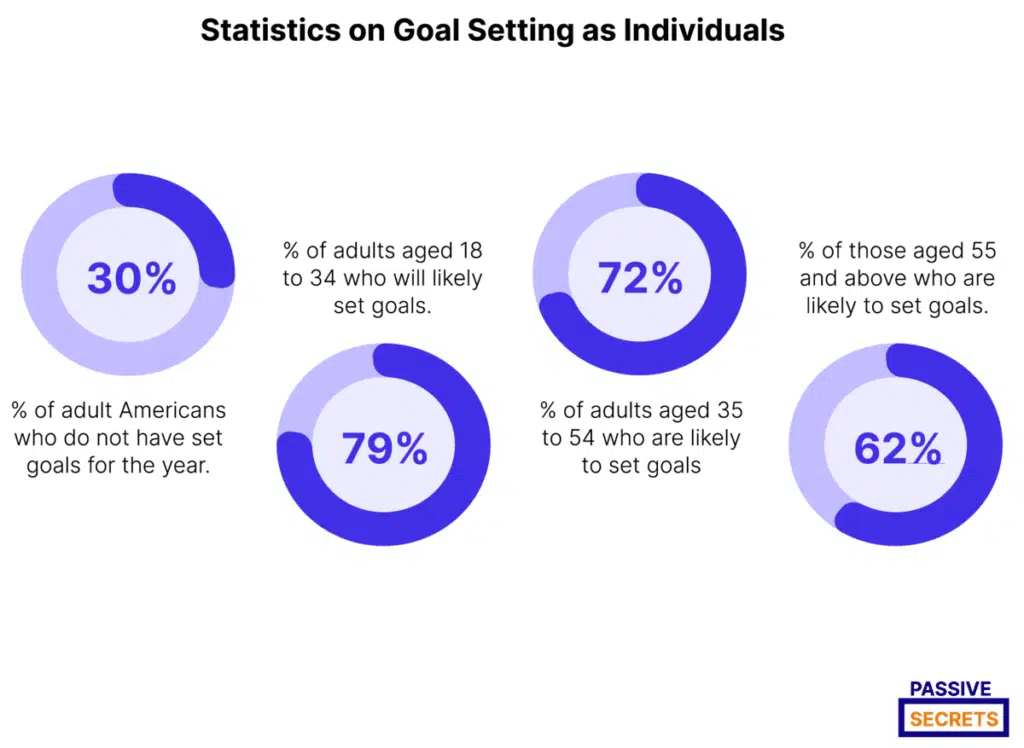
13. 38% of college graduates are very likely to set goals for themselves. This shows that education affects how people set goals for themselves. (source)
14. 36% of high-income earners ($90,000 and above) are very likely to set goals for themselves. (source)
15. Personal and fitness goals are the most common goals set among Americans. 80% of adults in the U.S. set personal health or fitness goals, and 69% set financial goals. (source)
Other common set goals include:
- Personal development (59%)
- Work or career goals (50%)
- Relationship or social life goals (40%)
- Religious or spiritual goals (32%)
16. 33% of Americans will most likely set goals, 38% are somewhat likely, 21% are not very likely, and 9% are not likely at all. (source)
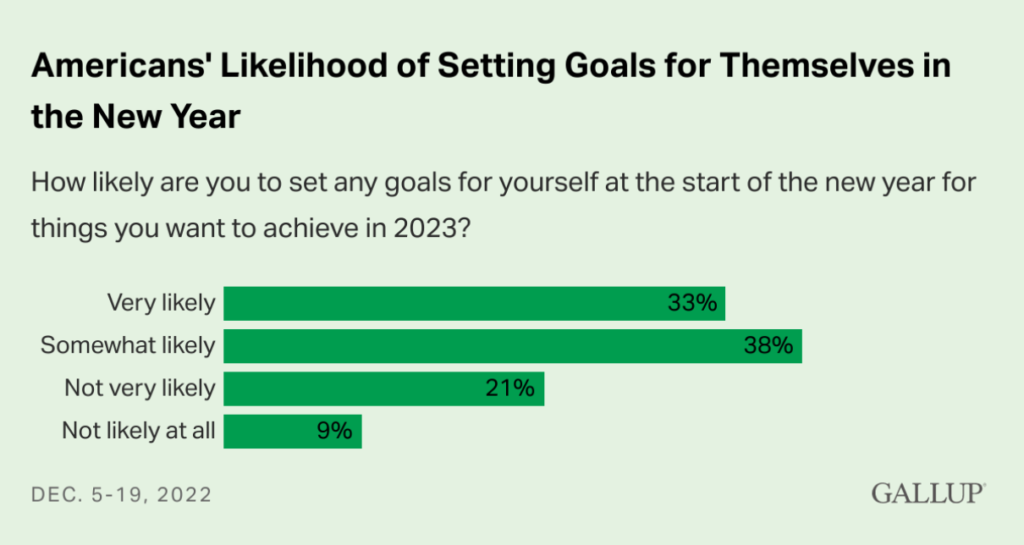
17. 6% of adults admit that they will not do anything more than write their goals down and plan to achieve them. However, they are mostly unsuccessful because focus is needed to complete goals. (source)
18. 49% of people admit that they only create an action plan that specifies all the steps needed to achieve their goals. (source)
19. 95% say they will continue focusing on their goals throughout the year. (source)
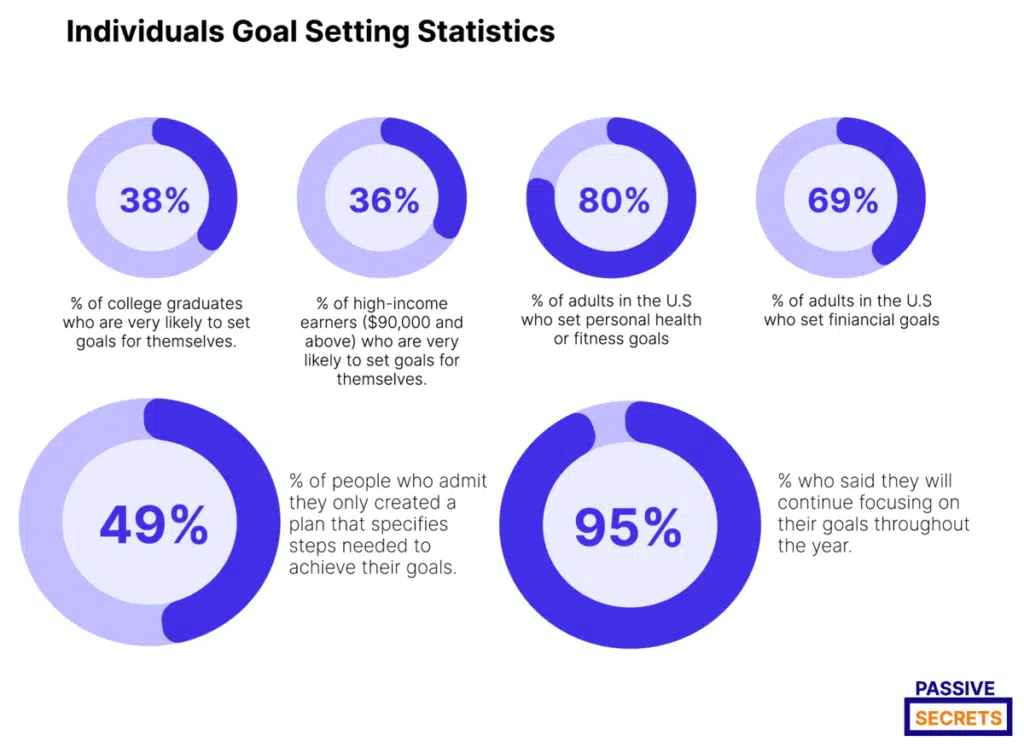
20. 34% of goal-setters agree that they never write down their goals or create specific steps to follow to help them focus. (source)
21. 32% of goal-setters are described as diligent planners. This statistic shows only one-third of people write down their goals for the year and create specific plans to achieve them. They also focus on these goals throughout the year. This category of people is more successful in achieving results than other people. (source)
Statistics on Goal Setting at Workplaces
22. 40% of workers in America say that they have become successful without setting specific goals. (source)
23. Goal setting leads to increased efficiency and productivity in workplaces. By setting clear goals and objectives, individuals and teams can prioritize the important things, curtail distractions, and stay focused. (source)
24. Goal clarity is positively related to overall workplace motivation and satisfaction. (source)
25. 85% of organizations say that their key goals and expectations are not clearly defined in a way that the employees can engage. (source)
26. 93% of workers claim that the lack of clarity on the company’s overall goals hinders them from aligning their personal goals to achieve the best outcomes. (source)
27. 70% of workers indicate that a lack of clarity jeopardizes their company’s overall goals and expectations. (source)
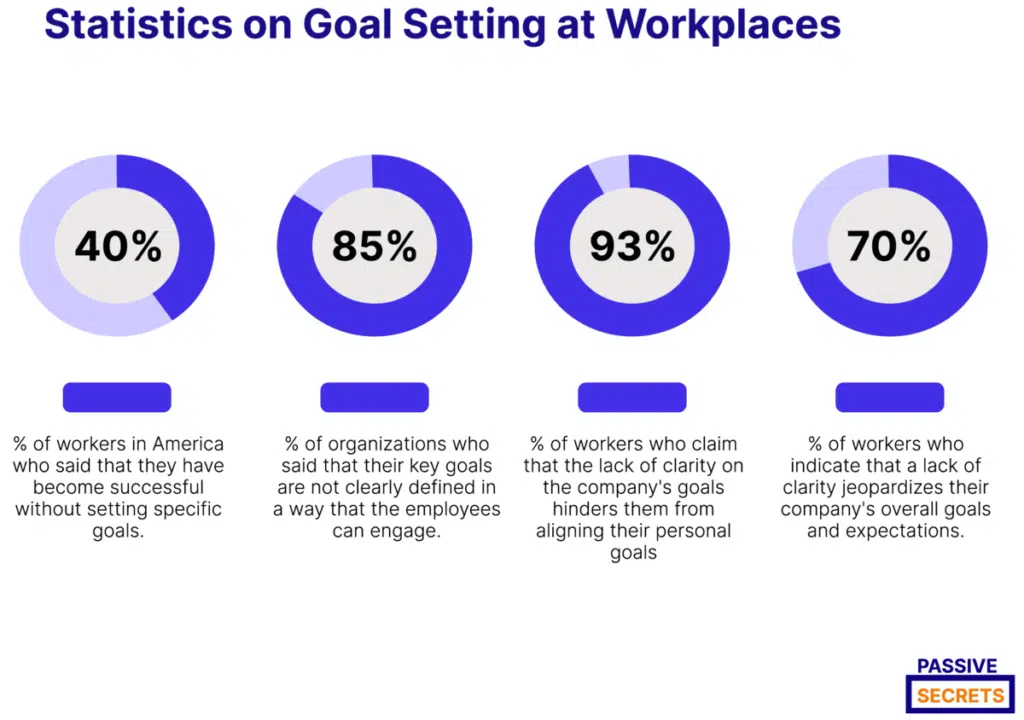
Importance of Constant Goal Evaluation in Workplaces
28. Tracking and constantly evaluating goal progress helps identify trends and patterns. This allows for informed decision-making and data-driven adjustments for forthcoming achievements. (source)
29. 36% of employees say their lack of performance evaluation and adjustment from supervisors affects them significantly when it comes to achieving goals. (source)
Employee Goal Setting Statistics
30. Employees who set goals are 14.2× more likely to be inspired at work. (source)
31. Employees with goals are 3.6× more likely to be committed to their organization. These employees are 6.7× more likely to feel proud of their companies and 6.5× more likely to recommend their organizations as a great workplace. (source)
32. Only 42% of employees with no goals feel their ideas are taken seriously. The other 58% feel their ideas are quickly discarded. However, 80% of employees with goals feel empowered and say their ideas are taken seriously. (source)
33. Employees who receive support and encouragement from their team are 11.6× more likely to put more effort into achieving work goals. This is because they are 7.5× more likely to feel their organization trusts them with important decisions. Hence, these employees are 8.9× more likely to think their ideas are essential to the company’s growth. (source)
34. Employees who see how their personal goals connect to the company’s goals feel inspired and motivated to work. This creates a sense of commitment for such employees. (source)
35. 23% of employees do not see how achieving their personal goals would directly impact their organizations. (source)
36. 76% of CEOs and management cascade their company goals. As a result, the clarity of these goals decreases so that only 16% of the employees at the bottom have a clear understanding of them. (source)
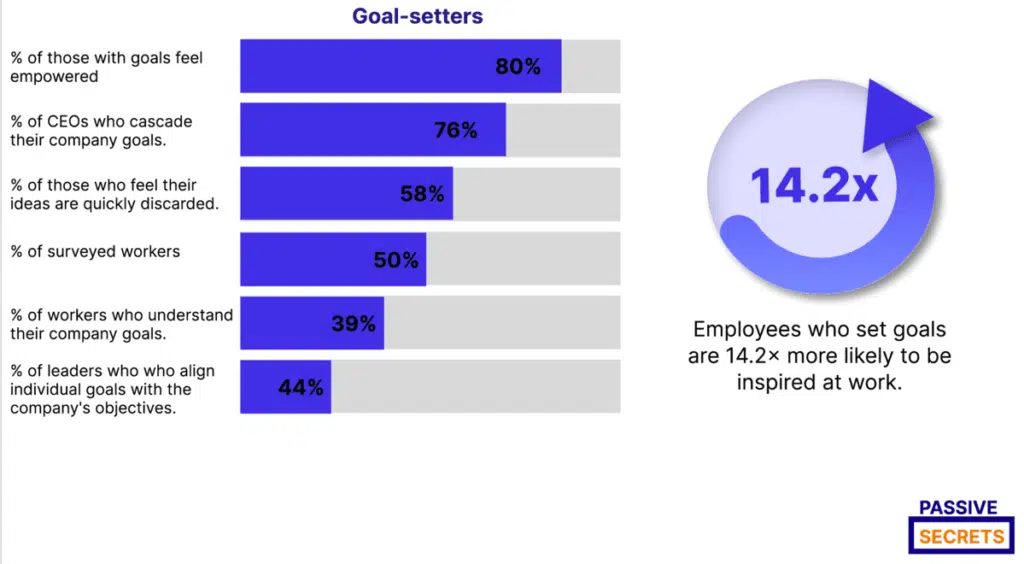
37. Having clear goals helps employees manage their time more effectively. (source)
38. Employees whose goals align with the company’s objectives are 8.9× more likely to think that their jobs are important and 7.2× more likely to value the company’s mission. (source)
39. Employees who set goals are 6.5× more likely to think that their jobs allow them to master other soft skills. This makes them more confident that their employers provide more opportunities for them. (source)
40. 31% of employees claim their supervisors do not set challenging enough goals for them. The goals were primarily attainable, but employees want goals that will drive them out of their comfort zones. (source)
41. Employees are 5× more likely to consider their jobs inspiring when their supervisors constantly evaluate their goals. (source)
42. Employees claim that when their supervisors adjust their goals according to current priorities from time to time, it makes them 6.7× more motivated to take action at work. Employees also claim that this simple act brings out their best ideas. (source)
43. Only 39% of workers understand their company goals. More workers understand their personal goals (78%) and their team goals (63%). Unfortunately, a high majority cannot say the same for their company goals, affecting productivity. (source)
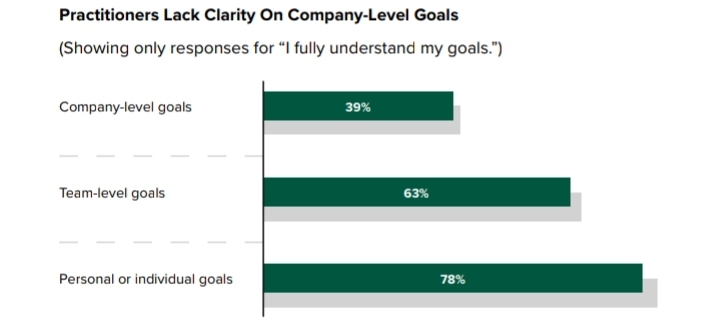
44. 50% of surveyed workers say they want their managers to properly demonstrate how individual goals contribute to the key company objectives. Unfortunately, 30% of leaders find aligning individual goals with the company’s overall objectives difficult. (source)
45. Surveyed practitioners reported that feeling confident and connected to their goals led to increased job satisfaction (54%), commitment to the company (44%), and motivation to work harder (44%). (source)
46. Practitioners suggest improving goal-setting and management by providing more frequent progress updates about set goals. (source)
Statistics on Goals Setting Software and Tools
47. 98% of company leaders say their company is a goal framework. (source)
48. 90% of OKR users who use goal-management software update their progress on their goals at least once a month.
(source)
49. 65% of companies who do not use OKR as a goal management software forget to check on their goals frequently. (source)
50. Almost two-thirds of surveyed leaders say their companies use performance-management tools to set and manage goals. (source)
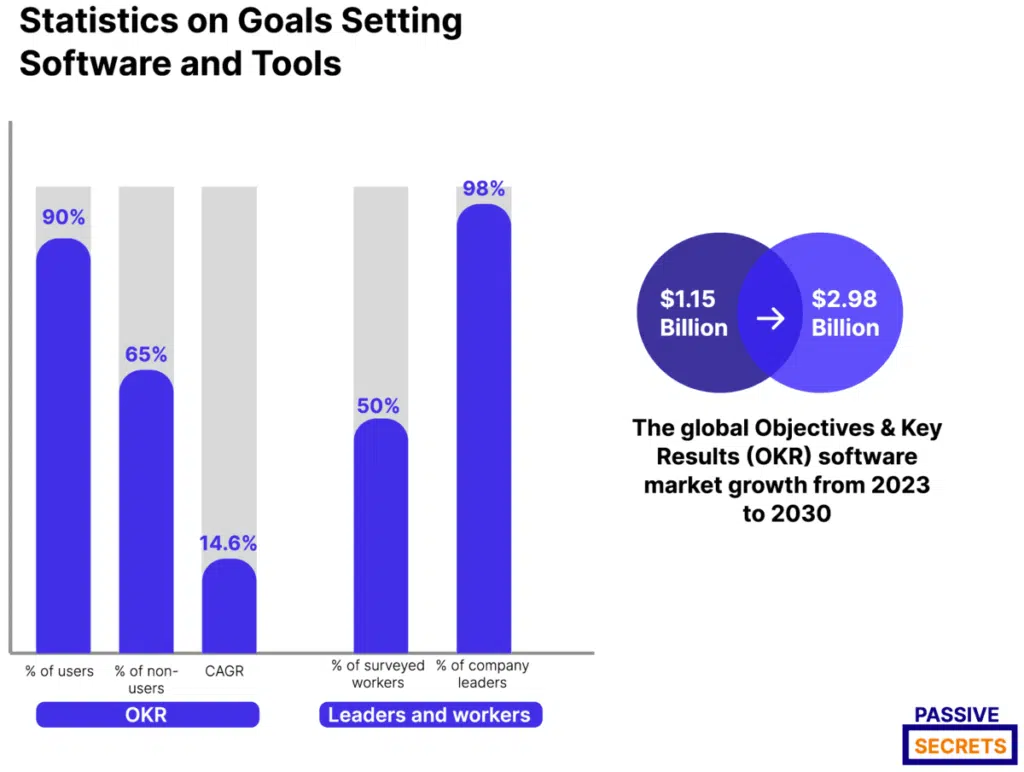
51. A tool called “Engagedly” helps to break down overall objectives into smaller and attainable goals for individuals and teams. (source)
52. According to 50% of surveyed workers, clear goals boost their motivation and sense of purpose. (source)
53. Engagedly also encourages collaborative goal setting as it allows managers and employees to work together to define goals. This promotes open communication and a shared sense of responsibility. (source)
54. The global Objectives & Key Results (OKR) software market is expected to grow from $1.15 billion in 2023 to $2.98 billion by 2030, representing a 14.6% CAGR over the forecast period. (source)
Final thoughts
According to our goal-setting research, the ability to set and achieve goals is vital for both individuals and organizations.
Setting goals can help individuals gain focus and direction and a sense of accomplishment when they are achieved.
In the workplace, goals can align employees around a common purpose and give them a sense of progress and achievement.
In both cases, goal setting can help to increase motivation, focus, and productivity.
Without goals, it can be easy to lose sight of what is important and become sidetracked or overwhelmed.
Frequently Asked Questions
1. What is a SMART Goal?
A SMART goal is a specific, measurable, attainable, relevant, and time-bound goal set. These metrics help with maintaining a certain standard for your goals.
2. Why is Goal Setting Necessary in Workplaces?
Goal setting is essential in workplaces because it helps motivate employees to work hard and prioritize the more important work.
3. What are Some Helpful Goals to Have in the Workplace?
- Time management goals
- Knowledge goals
- Skill enhancement goals
- Relationship goals
4. Why is it Important to Monitor and Measure Goals?
Goals need to be monitored and measured to determine whether they are accomplished. A metric needs to be established so that employers and employees can periodically check on their progress.
5. What Challenges Do People Face When It Comes to Goal Setting?
The biggest challenge is the lack of motivation to work. However, this challenge can be solved by recognizing why the goals were set in the first place and what the accomplishments of those goals will do for you.

Related Posts:
- 50+ Call Center Statistics And Big Trends [Latest 2024 Report]
- 47+ Important 4-day Work Week Statistics [2024]
- Ultimate List of Performance Management Statistics & Trends in 2024 (Full Report)
- 71 Important Workplace Communication Statistics To Know in 2024
- 55 Teamwork & Workplace Collaboration Statistics To Boost Your Employee Performance
- 25+ Best Emotional Intelligence Statistics to Know in 2024
- 40+ Top Workplace Conflict Statistics You Should Know In 2024
- 73 Revealing Workplace Distraction Statistics [2024]
- 45+ Important Communication Skills Statistics & Trends for 2024
- 50+ Latest Life Coaching Statistics and Trends in 2024
- 36 Interesting Social Worker Burnout Statistics for 2024
- 35 Important Public Speaking Statistics To Help You in 2024
- 20 Crucial Body Language Statistics To Know In 2024

